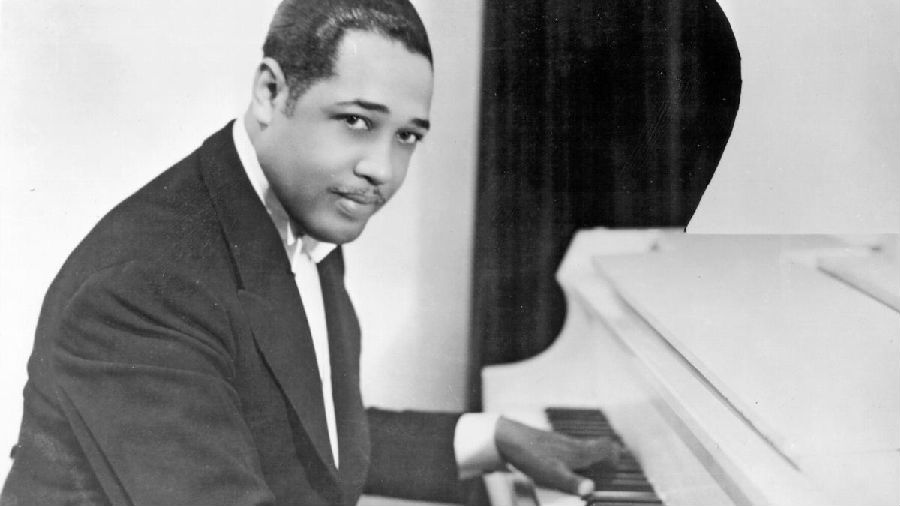(单词翻译:单击)
听力文本
I'm Shirley Griffith. And I'm Ray Freeman with the VOA Special English program PEOPLE IN AMERICA. Every week we tell about a person who was important in the history of the United States. Today, we tell about the great jazz musician, Edward Kennedy Ellington. He was better known to the world as "Duke" Ellington.
That was Duke Ellington's orchestra playing "Take the 'A' Train." Just the first few notes of that song are enough to tell any music expert who is playing. It is like a musical sign. The sign says, "Listen! You are about to hear something by Duke Ellington's orchestra." It was always the first song his orchestra played. "Take the 'A' Train" was only one of hundreds of songs he played all over the world. Edward Kennedy Ellington was born on April twenty-ninth, eighteen ninety-nine, in Washington, D.C. His family lived in the African-American area of Washington. It was a time when racial separation was the law in much of the United States. Racial laws and racial hatred were to follow Edward Kennedy Ellington all through his life.
A friend once called him "Duke" because he liked clothes so much, like a member of a royal family. Young Edward liked clothes. A friend once looked at him and said, "You look like a duke." He meant that Edward 's clothes were so good that he looked like a member of a royal family. Other friends laughed. Yet they all began calling him "Duke." The name stayed with him the rest of his life. When he was about seven years old, Duke Ellington began to play the piano. When he was in high school, he began to paint. He became very good at both. A famous art school in New York City invited him to take classes there. But he had already decided to become a musician. He got his first professional job in nineteen sixteen. He played music at night and painted business signs during the day.

The most popular music back then was called ragtime. Duke listened to ragtime piano players who visited Washington. Then he tried to play as well or better than they did. Years later, he recorded a song that showed how well he could play the piano. It is a ragtime song called "Lots o' Fingers." Duke Ellington moved to New York City in nineteen twenty-three. He had a small band. Soon it was playing at the famous Cotton Club, where it would play for many years. Duke and his band could play at the Cotton Club. But they could not come to hear anyone else, because they were black.
Duke did not become angry. He did not become filled with hatred toward white people. He let his music speak for him."Take the 'A' Train" was Duke Ellington's most famous song. In time, Duke Ellington's band got bigger. It was a jazz orchestra. More people began hearing the orchestra's music. They could hear it on a radio program from the Cotton Club. The program often could be heard all over the United States. At the same time, Duke Ellington and the members of his orchestra began recording their songs. Their first hit record was one of their most famous. It was recorded in October of nineteen thirty. It was called "Dreamy Blues." Later, Duke changed the name. It is still considered a great blues song and is often played today. It is called "Mood Indigo."
An orchestra is a team made up of individual players. Like any team, the individuals in an orchestra must cooperate to produce good music. The leader of a team, or an orchestra, must learn the strength and the weakness of each member. And a good leader will use this knowledge to make the team or orchestra produce the best result. In the nineteen twenties and nineteen thirties, members of a dance orchestra never stayed with one group for long. Musicians moved from group to group. Yet, when a musician played with Duke Ellington, he usually stayed, sometimes for many years.
This had an effect on the group's music. Duke would write music especially for musicians in the orchestra. His songs used the strengths of one or two individuals. The rest of the orchestra cooperated with them. This cooperation became the method Ellington used again and again to produce beautiful sound colors. His music could make people feel deep emotions -- feelings of happiness, or sadness, or loneliness or joy. Some members of the Duke Ellington orchestra were the best jazz musicians of their day. Their cooperation produced a sound that is almost impossible for others to re-create. To create that same sound, you would need the musicians who first played the music.
One of those musicians was "Cootie" Williams. He played the trumpet in the Duke Ellington orchestra for many years. Duke Ellington used the strength of Cootie Williams when he wrote a song called, "A Concerto for Cootie." Critics said this work showed the unity between the music writer, the leader of the orchestra, and its members. Listen as Cootie Williams seems to lead the orchestra. Hear how the other members cooperate with him to produce a very beautiful and special sound.
重点解析
1.separation 分离;隔离
He believes in the separation of the races.
他信奉种族隔离政策。
2.royal 皇家的
...an invitation to a royal garden party
参加皇家游园会的邀请
3.invite 邀请
Barron invited her to accompany him to the races.
巴伦邀请了她陪他去看比赛。
4.professional 专业的;职业的
His professional career started at Colgate University.
他的职业生涯始于科尔盖特大学。
5.hatred 憎恨;仇恨
Her hatred of them would never lead her to murder.
她对他们的仇恨永远不会将她引向凶杀。
6.orchestra 管弦乐队
She plays the flute in the school orchestra.
她在校管弦乐队里吹长笛。
参考译文
我是雪莉·格里菲斯。我是瑞伊·弗里曼。这里是VOA慢速英语栏目《美国人物志》。每周我们都会讲述一个美国历史上的重要人物。今天,我们将讲述伟大的爵士音乐家爱德华·肯尼迪·艾灵顿。他以艾灵顿公爵一名而为世界所知。这是艾灵顿公爵的管弦乐队演奏的《Take the A Train》。这首曲子的头几个音符就足以告诉任何音乐专家是谁在演奏。这就像是一个音乐符号。这个符号说,“听!你将要听到艾灵顿公爵管弦乐队的音乐”。每次演奏,他的管弦乐队首先就会演奏这首曲子。《Take the A Train》只是他全球演奏的数百首曲子中的一首。
1899年4月29日,爱德华·肯尼迪·艾灵顿出生于华盛顿。他们家住在华盛顿非裔美国人区。那时种族隔离是美国很多地方的法律。种族法律和种族仇恨伴随爱德华·肯尼迪·艾灵顿一生。年轻的爱德华喜欢服装。一位朋友曾看着他说,“你看起来像一名公爵。”他指的是爱德华的衣服很好,让他看起来像皇室成员一样。其他朋友笑着。但是他们都开始叫他‘公爵’。这个名字伴随他的余生。在他大概7岁的时候,艾灵顿公爵开始弹钢琴。高中的时候,他开始画画。两者他都很擅长。纽约的一所著名艺术学校邀请他去上课。但是他已经决定成为一名音乐家。
1916年,他获得了自己的第一份专业工作。他晚上奏乐,白天画商业标识。那时最流行的音乐是繁音拍子。公爵听着那些来访华盛顿的繁音拍子钢琴演奏家的演奏。然后,他试着谈得和他们一样好或是比他们更好。多年后,他收录了一首歌,展现他的钢琴技巧。这首繁音拍子曲子是《Lots o' Fingers》。1923年,艾灵顿公爵搬到了纽约。他有了一只小乐队。很快乐队在著名的棉花俱乐部表演,他们在那演奏多年。公爵和他的乐队可以在棉花俱乐部表演。但是他们不能在这观看他人表演,因为他们是黑人。公爵没有生气。他没有对白人充满仇恨。他让自己的音乐为他发言。
《Take the 'A' Train》是艾灵顿公爵最著名的曲子。艾灵顿公爵的乐队日益壮大,成了一只爵士管弦乐队。越开越多的人开始听管弦乐队的音乐。他们可以收听棉花俱乐部的广播节目。全美都在听这个节目。同时,艾灵顿公爵和他的管弦乐成员开始录制自己的曲子。他们首支热门唱片是他们最著名的唱片之一,收录于1930年10月,名为《Dreamy Blues》。之后,公爵改了名字。这仍被认为是一支很棒的蓝调曲子,如今也经常演奏,这首曲子是《Mood Indigo》。
管弦乐队是由个人乐手组成的团队。和其他团队一样,管弦乐队中的个人需要合作才能制成还得音乐。团队或管弦乐队的队长必须知道每位队员的优缺点。好的队长要利用这些让团队制作出最好的音乐。上世纪20、30年代,一支伴舞乐队的成员不会在一个团队呆很久。音乐人总是不断换团队。但是当一位音乐家和艾灵顿公爵演奏时,他通常会留下来,一呆就是很多年。这对团队的音乐产生了影响。公爵可以专门为管弦乐队中的音乐家写曲子。他的曲子利用一到两个人的优势。管弦乐队的其他人和他们合作。这种合作成为了艾灵顿一次又一次创作优美音乐的方法。他的音乐可以让人感受到深深的情感—快乐、忧伤、孤独或是欢乐。
艾灵顿公爵管弦乐队的一些成员是那时最好的爵士音乐家。他们的合作创造出了其他人几乎无法重塑的音乐。为了创造出同种声音,你将需要首位演奏该音乐的音乐人。其中一位音乐人是库提·威廉姆斯。他在艾灵顿管弦乐队中担任多年小号手。艾灵顿公爵利用库提·威廉姆斯的优势为他写了一首曲子《A Concerto for Cootie》。评论家认为这个作品展现了音乐作曲人、管弦乐队队长以及其成员之间的统一。请听库提·威廉姆斯带领乐队演奏。两位其他成员配合他演奏出一种非常美妙特别的声音。
译文为可可英语翻译,未经授权请勿转载!


